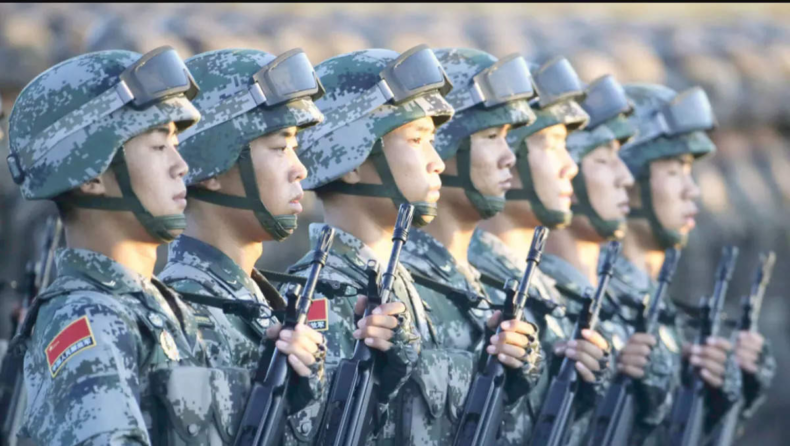China In response to US House Speaker Nancy Pelosi’s trip to Taiwan, which China claims as its own territory, China is holding live-fire military drills in six self-declared zones around Taiwan.

China has told ships and planes to stay away from the areas where the drills are happening until Sunday. The drills look like practice for a possible blockade and invasion of the island, which would almost certainly involve the United States, which is Taiwan’s biggest supporter, as well as American allies like Japan and Australia.
China has the world’s largest army with 2 million people, and its navy has more ships than the US navy. Taiwan’s armed forces aren’t as big as China’s, but they have vowed to fight back if the Chinese Communist Party tries to use force to take over Taiwan’s democracy.
Kharis Templeman, a political scientist at Stanford University, said, “It will take some tough diplomacy to get things back to where they should be.” “I don’t know how this fight will end, but I think the next few weeks are going to be rough.” Here are some of the problems that have led to the tensions getting worse.
What is China doing in the waters and skies around Taiwan?
China says it has started exercises in six areas around Taiwan that involve warplanes, navy ships, and missile strikes. These are as close as 20 kilometers (12 miles) from the coast of the island, which could put them in Taiwan’s territorial waters.
Beijing hasn’t given many details, but it has said that the drills are a punishment for the US letting Pelosi’s trip to the island go ahead, even though President Joe Biden didn’t have the power to stop her from going.
Live-fire exercises are a way to see how well a military can do its job in conditions that are most like war. In this case, they are meant to show how much force China could use against Taiwan if Beijing kept its promise to take over the island and punish those who support its independence.
People think that these drills are the biggest and most dangerous toward Taiwan since 1995 and 1996 when China fired missiles into the water north and south of the island in response to President Lee Teng-trip huis to the US.
China often sends warplanes into Taiwan’s air defense identification zone, and sometimes they cross the line that separates the two sides of the Taiwan Strait. However, China hasn’t done any direct incursions or attacks that could start a regional war.
What does China want to get out of this?
China has said more and more strongly that Taiwan must be brought under its control, even if it means using force. This is against what Washington and other supporters of Taiwan’s democracy want. China’s President and head of the military, Xi Jinping, is getting ready to run for a third five-year term as head of the ruling Communist Party. Pelosi’s visit came at a very important time.
Xi hasn’t chosen a successor, and he has a lot of power, even though his handling of the economy has been criticized. This is partly because of his hardline approach to COVID-19 and a sharp drop in relations with the West.
Xi has said that Taiwan’s future can’t stay up in the air forever, and US military officials have said that China may try to find a military solution in the next few years.
China’s constitution includes Taiwan as its national territory, and its 2005 anti-secession law threatens invasion if “possibilities for peaceful reunification are exhausted,” referring to a formal declaration of independence or foreign intervention.
China insists that Taiwan accept Beijing’s claim that the island is part of China. Faced with China’s military threats and diplomatic isolation, islanders support de facto independence. Beijing’s ruthless crackdown on political rights and free speech in Hong Kong has reinforced this sentiment. China has long touted Hong Kong as a model for Taiwan’s future governance.
Taiwan and the US:
Taiwan has held civil defense and military drills. Its air force, navy, and 165,000-member armed forces are a fraction of China’s, but they have high-tech weaponry and early-warning systems to make a Chinese invasion difficult.
Taiwan is looking to overhaul training and tactics in response to Russia’s invasion of Ukraine, which China tacitly supported.
The aircraft carrier USS Ronald Reagan and its battle group are currently deployed near Taiwan. Washington has rejected China’s claim that the Taiwan Strait is sovereign Chinese territory and maintains the right to sail past Chinese outposts in the South China Sea.
How long will tensions last, and what are the risks?
It’s still not clear if China will try to keep things tense even after the current round of exercises is over. Spokespeople from the Foreign and Defense Ministries, the Taiwan Affairs Office of the Cabinet, and other departments have said that President Tsai’s Ing-government and the U.S. government will pay a price for Pelosi’s visit, but they haven’t said how or when this will happen.
Given the scale of the Chinese exercises, White House National Security Advisor Jake Sullivan said after the visit, “an incident is possible.”
“We think China’s actions are irresponsible,” Sullivan said it unnecessarily escalates tensions. Both sides are “seriously challenging” the long-standing modus vivendi between Washington and Beijing said, Templeman.
Washington has countered Beijing with high-level visits, relaxed contact restrictions, and arms sales.













